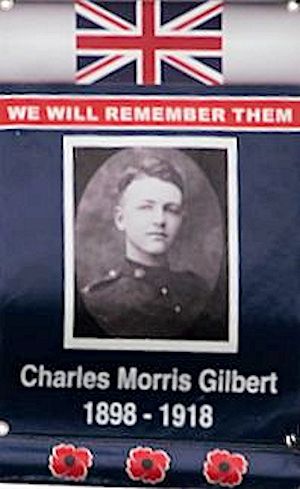In yesterday’s Part 13 of ‘Lives behind the Commemorative Banners’, we highlighted Charles Morris Gilbert, but the story barely scratched the surface of this young man’s life.
Thanks to G. William (Bill) Streeter and his research, we now have the whole story.
 Charlie Gilbert was born in Port Elgin on April 4, 1898, the eldest son of Charles and Maggie Gilbert. His younger brother Elgin also enlisted in the Canadian Army. Charles grew up to be a fair skinned young man on a 5’ 11” frame with blue eyes and light brown hair. His family attended the Port Elgin Anglican Church.
Charlie Gilbert was born in Port Elgin on April 4, 1898, the eldest son of Charles and Maggie Gilbert. His younger brother Elgin also enlisted in the Canadian Army. Charles grew up to be a fair skinned young man on a 5’ 11” frame with blue eyes and light brown hair. His family attended the Port Elgin Anglican Church.
After leaving school, Charles was employed by the Eaton’s Company as a Mail Order shipper working in Toronto. Then, in 1916, he returned to Port Elgin to enlist in the 160th Bruce Battalion. On March 1st, when he went to enlist, he found out that he had to be 18 years of age to join and he was one month short of being that age. The enlisting Sergeant provided an age certificate to him and allowed him to sign up knowing that in one month he would be of legal age.
The Port Elgin enlistees started training and, in late May 1916, relocated to Walkerton to join with the other groups from around Bruce County. In June the 160th Bruce Battalion had grown to more than 1,200 volunteers. They then travelled by train to London to further their basic training.
Prior to being shipped out to England, Charlie was found to have a hernia that required surgery. He was admitted to the Military Hospital in London on September 26th and was operated on September 27th and discharged on October 11th. Immediately, upon his release he had to prepare for the trip to Halifax with his 160th comrades to prepare for the trip to England. On October 17th, they boarded the S. S. Metagama. The ship was a recent new addition to the Canada Steamships fleet. The fresh army troops filled the 3rd Class Cabins below decks while the paying customers got the 1st and 2nd classrooms on the upper decks.
They arrived in Liverpool on October 28th and were sent to the Bramshott Military Camp in Hampshire. The next month, on November 24th, Private Gilbert received his first promotion, to Acting Lance Corporal. Military training continued at the Witley Camp, close to Bramshott. On April 2n, 1917 Lance Corporal Gilbert was promoted again, this time to Acting Corporal.
In July 1917, Charlie started having health issues, suffering from Colic. He was assigned to clerical duties. Sadly, on July 20th he requested to revert to the rank of Private recognizing that he could not continue as a regular soldier. He continued doing clerical duties at the Ashford Command Office. On October 9th, he was hospitalized at Shorncliffe for Colic and was sent to the Canadian Convalescence Hospital in Monks Horton on October 20th . He was discharged from hospital on October 26th and returned to his duties at Ashford. He spent the next few months doing clerical duty and was awarded a Good Conduct Medal on April 18, 1918. On May 2nd, he was graded as a Class 1 Clerk.
In July of 1918, his old hernia surgery from 1916 became problematic and he was sent to the Granville Canadian Special Hospital in Buxton, Derbyshire in England’s North West for what turned out to be a double hernia surgery. That came with considerable complications. He had to be fitted with a truss for his inguinal hernia. He remained in Buxton for an extended recovery period.
In early October 1918, he returned to Hospital in Buxton; this time with a horrible case of pneumonia. On October 18th, at the age of 20 years and 6 months he died.
He was buried at the Buxton Cemetery near the hospital. It is a very small cemetery in the North West of England with only 76 WWI burials and 29 of them are Canadian.
In the short time that Charles was in England, his parents moved to Toronto, where they were residing at the time of his death. His name is amongst the 3,327 Eaton’s employees named on the WWI Eaton’s Employee memorial, on display in the Eaton Centre on the corner of Young and Dundas Streets in Toronto.
He was a brave young man who died much to early in his life.
“We Will Remember Them”
Researched by G. William Streeter












